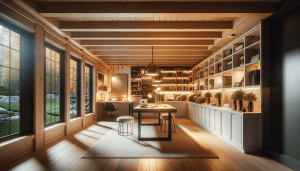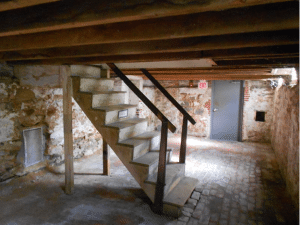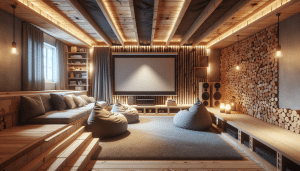A well-lit basement doesn’t just look better—it feels bigger, warmer, and more inviting. But basements can be tricky. Lower ceilings, fewer Windows, and different zones competing for attention. The right lighting plan balances all that, so your remodel doesn’t end up bright in the wrong places and dim where you need it most. If you live along the Wasatch Front—Salt Lake County, Davis County, or Utah County—you also know winter’s short days add pressure to get this right. Let’s make your basement feel like the favorite room in the house.
Contents
- 1 Start with the big question: what’s this space for?
- 2 Basement reality check: natural light is limited, so fake it smart
- 3 Layered lighting: the not-so-secret sauce
- 4 Fixtures that play nice with lower ceilings
- 5 Color temperature and CRI: how the room actually feels
- 6 Smart controls and dimming: less fiddling, more comfort
- 7 Glare, shadows, and “Why does my TV feel too bright?”
- 8 Energy, Cost, and the long game
- 9 Common mistakes we see (and how to dodge them)
- 10 A simple plan you can sketch tonight
- 11 Seasonal sanity: Utah winters and summer nights
- 12 Products and specs we reach for (because they behave)
- 13 Safety and code: the quick version
- 14 Ready to make it feel like the upstairs—only better?
Start with the big question: what’s this space for?
Lighting should follow function, not the other way around. Are you building a family hangout, a home theater, a guest suite, or a work-from-home nook that doesn’t feel like a cave? Different uses need different levels of light and different fixture types.
Here’s a simple yardstick: think in lumens per square foot. For general living spaces, aim for 20–30 lumens per square foot. For task zones—desks, craft tables, laundry counters—target 50–70. Media rooms? Lower overall light with dimming and soft accents. It sounds technical, but it saves you from guesswork later.
You know what? It helps to sketch zones on a floor plan: seating, pathways, bar, play area, storage. That quick doodle becomes your lighting roadmap.
Basement reality check: natural light is limited, so fake it smart
Even with egress windows and wells, basements in Utah don’t get much sunlight. That’s okay. You can “borrow” brightness with wall-washing fixtures and lighter paint (look for high LRV paint—think 70+). Mirrors help, but they aren’t magic; the lighting still does the heavy lifting.
A gentle trick: light the walls more than the floor. When walls feel bright, the room reads as larger. Recessed wall-wash trims or adjustable downlights aimed at art or shelves work wonders, especially in long, narrow rooms.
Layered lighting: the not-so-secret sauce
One ceiling light in the middle won’t cut it. Most basements need three layers:
- Ambient – Your base layer. Think recessed LED wafers, low-profile flush mounts, or linear fixtures. Soft, even light that fills the room.
- Task – Focused light where you work: pendants over a bar, under-cabinet strips, a floor lamp by the reading chair, a desk lamp with a high-CRI LED.
- Accent – The mood layer. Wall sconces, picture lights, LED strips on shelves, or behind the TV for bias lighting.
Here’s the contradiction: bright is good… until it’s not. A media room wants cozy layers and deep dimming, while a craft table needs clarity and punch. The trick is giving each zone its own control.
Fixtures that play nice with lower ceilings
Utah basements often have 7 to 8 foot ceilings. That changes your fixture choices. Anything bulky will feel heavy overhead. Keep it slim, safe, and straightforward:
- 4-inch canless LEDs – Ultra-thin, IC-rated wafers tuck neatly into tight joists. Use baffle trims to cut glare.
- Low-profile flush mounts – Great for Bedrooms, storage rooms, or hallways. Look for 90+ CRI models if this will be a guest space.
- Pendants (carefully) – Over a bar or game table, keep the drop tight so no one bumps a head. Frosted or fabric shades soften hotspots.
- LED strips – Under shelves, stair skirting, or cove details. Subtle and surprisingly helpful for wayfinding at night.
Spacing recessed lights? A simple rule: space them about half the ceiling height. With an 8-foot ceiling, that’s roughly 4 feet between fixtures, and about 2 feet off the walls. Adjust for furniture and focal points.
Color temperature and CRI: how the room actually feels
Color temperature is measured in Kelvin (K). Lower numbers look warmer, like a cozy lamp. Higher numbers look cooler, more like daylight. CRI (Color Rendering Index) tells you how true colors appear under the light.
General guide for basements along the Wasatch Front:
- 2700–3000K – Warm, relaxing. Great for family rooms and theaters.
- 3000–3500K – Neutral and versatile. Works for playrooms and multipurpose spaces.
- 3500–4000K – Brighter, crisper. Good for offices, craft tables, and laundry areas.
- CRI 90+ – Preferred where skin tones, fabrics, and wood matter (guest rooms, offices, and Bars). Look for R9 values above 50 for better reds.
Honestly, adjustable-white fixtures are worth it. Set 4000K for work-from-home days, then warm it to 2700K for movie night. You’ll use that feature more than you think.
Smart controls and dimming: less fiddling, more comfort
Separate the basement into zones and give each zone dimming. It sounds fancy, but it’s really about everyday comfort. A few brands we trust locally:
- Lutron Caséta or Maestro – Rock-solid dimming with LED compatibility. Caséta pairs with smart homes easily.
- Leviton Decora Smart – Clean look, reliable apps, and smooth scenes.
- Philips Hue – Great for accent lighting, color scenes, and bias lighting behind TVs.
For storage rooms and the under-Stairs closet, vacancy sensors are a small luxury—lights only turn on when you want them to. And remember, stairways usually need a 3-way control; it’s safer and code-friendly.
Glare, shadows, and “Why does my TV feel too bright?”
Glare sneaks up on you. Put a downlight directly above a sofa and you’ll see it reflected on the TV. Aim them slightly behind the seating line or toward the walls. For bars, skip clear-glass pendants unless the bulbs are frosted or shaded. Harsh points of light make a space feel harsher than it is.
Bias lighting behind a TV (an LED strip) reduces eye strain and makes blacks look richer. It’s a small trick with a big payoff.
Energy, Cost, and the long game
LEDs save money and stay cool. That matters in basements where airflow can be limited. Look for ENERGY STAR ratings and dimmer compatibility specifically listed on the box—this helps prevent flicker. A 9–12W LED roughly equals an old 60W bulb, and the light quality is better when CRI is high.
Plan for fewer watts per circuit than you think. The savings add up, and you’ll have headroom if you add fixtures later. Also, go with IC-rated sealed fixtures for recessed cans in basements—less air leakage and more comfort in January.
Common mistakes we see (and how to dodge them)
- Too few fixtures – Then you chase brightness with brighter bulbs and get glare. Start with even coverage, then layer.
- One switch for everything – Zones need their own control. It’s not a mansion thing; it’s a comfort thing.
- Cool, blue light everywhere – 5000K feels chilly in a basement. Keep cooler light for task corners only.
- Ignoring furniture layout – Plan lights around where heads, eyes, and screens will be. Your couch matters more than your ceiling joists.
- No dimming – You’ll want it, especially in the evening. It’s budget-friendly now and priceless later.
- Shiny trims – High-gloss reflectors look sleek but can glare. Baffles are kinder on eyes.
A simple plan you can sketch tonight
Let me explain how we’d rough-in a 300 sq ft family room with an 8-foot ceiling that doubles as a play space:
We’d target about 6,000–9,000 lumens total. That could look like 8 recessed 4-inch wafers at ~800 lumens each (6,400 lumens), plus a couple of lamps and a slim wall sconce. Place recessed fixtures ~4 feet apart, keep them about 2 feet off the walls, and leave a “quiet” area above the TV to reduce reflection. Add LED strip bias lighting behind the screen. Then, set all ceiling lights on a dimmer and give the sconce its own switch.
For a small office corner (say 5×8), we’d warm things a bit but keep clarity: a 3500K flush mount overhead, 90+ CRI, plus a task lamp aimed at the desk—not your eyes. It’s a tiny zone; it still deserves its own control.
And if there’s a wet bar? Two small pendants with frosted glass over the counter, under-cabinet LED tape at 3000K, and a dimmer that nudges the bar slightly darker than the seating area. Subtle, but it sets the mood.
Seasonal sanity: Utah winters and summer nights
In January, when the inversion hangs low and sunsets are basically a rumor, warm dimming helps the whole basement feel welcoming. Choose fixtures that can slide from 3000K down to 2200K in the evening. In July, when the basement is your cool retreat after a day up Big Cottonwood, bump the color temperature back up for crisp detail on game night.
Small touch, big difference.
Products and specs we reach for (because they behave)
We’re brand-agnostic, but a few things consistently make basements better:
- 4″ IC-rated wafer lights – 700–900 lumens, 90+ CRI, selectable 2700–4000K, baffle trim, airtight.
- Under-cabinet LED tape – 90+ CRI, diffused channels, hardwired with a dimmer. No “dots” on the backsplash.
- Lutron Caséta dimmers – Reliable with LEDs, smart scenes you’ll actually use.
- Quality lamps – Floor and table lamps aren’t afterthoughts; they finish the room. Look for shades that hide the bulb.
One more nerdy note: pick drivers and dimmers that promise low flicker at every level. Your eyes will thank you during long movie nights.
Safety and code: the quick version
Use IC-rated, airtight recessed fixtures for insulated ceilings; it’s safer and keeps heat where it belongs. Put GFCI protection near wet bars and sinks. Stairways need proper illumination with two switches. And for anything complicated—new circuits, panel work, or smart systems—bring in a licensed electrician. We handle all that when we remodel; you shouldn’t have to worry about it.
Ready to make it feel like the upstairs—only better?
Lighting is where a basement goes from finished to fantastic. The right layout, the right color temp, the right dimmers—it’s the polish you notice every day, especially here in Utah with our bright summers and dim winters. If you want a plan that fits your space, your family, and your budget, we’re happy to help.
Call Utah Basement Finishing at 801-515-3473 or Request a Free Quote. We’ll listen, measure, sketch, and build a lighting plan that makes your remodel shine—literally and figuratively.




